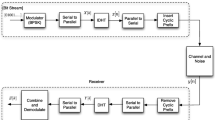Abstract
In this paper a new method is proposed to perform the N-Radon orthogonal frequency division multiplexing (OFDM), which are equivalent to 4-quadrature amplitude modulation (QAM), 16-QAM, 64-QAM, 256-QAM, ... etc. in spectral efficiency. This non conventional method is proposed in order to reduce the constellation energy and increase spectral efficiency. The proposed method gives a significant improvement in Bit Error Rate performance, and keeps bandwidth efficiency and spectrum shape as good as conventional Fast Fourier Transform based OFDM. The new structure was tested and compared with conventional OFDM for Additive White Gaussian Noise, flat, and multi-path selective fading channels. Simulation tests were generated for different channels parameters values including multi-path gains vector, multi-path delay time vector, and maximum Doppler shift.
Similar content being viewed by others
References
Shin O. S., Chan A. M., Kung H. T., Tarokh V. (2007) Design of an OFDM cooperative space-time diversity system. IEEE Transactions on Vehicular Technology 56(4): 2203–2215
Al-Dhahir N., Cioffi J. M. (1996) Optimum finite-length equalization for multicarrier transceivers. IEEE Transactions on Communications 44(1): 56–64
Zhang, H., Yuan, D., & Pätzold, M. (2007). Novel study on PAPRs reduction in wavelet-based multicarrier modulation systems. Elsevier Inc, Digital Signal Processing, 17, 272–279.
Weinstein S., Ebert P. (1971) Data transmission by frequency division multiplexing using the discrete fourier transform. IEEE Transaction on Communication Technology COM-19: 628–634
Nghi N. H., Nguyen H. H. (2007) IEEE, and Tho Le-Ngoc Bit-interleaved coded OFDM with signal space diversity: Subcarrier grouping and rotation matrix design. IEEE Transactions on Signal Processing 55(3): 1137–1149
Lawrey, E. (Oct 1997). The Suitability of OFDM as a modulation technique for wireless telecommunications, with a CDMA Comparison. Thesis, James Cook University.
Jeon W.G., Chang K.H., Cho Y.S. (1999) An equalization technique for orthogonal frequency-division multiplexing systems in time-variant multipath channels. IEEE Transactions On Communications 47(1): 27–32
Nee R. V., Prasad R. (2000) OFDM for wireless multimedia communications. Artech House, London, UK
Koffman I., Roman V. (2002) Broadband wireless access solutions based on OFDM access in IEEE 802.16. IEEE Communications Magazine 40(4): 96–103
Lee I., Chow J. S., Cioffi J. M. (2007) Performance evaluation of a fast computation algorithm for the DMT in high-speed subscriber loop. IEEE Journal on Selected Areas in Communications 13(9): 1564–1570
Prasad R. (2004) OFDM for Wireless Communications Systems. Artech House, London, UK
Batra A., Balakrishnan J., Aiello G. R., Foerster J. R., Dabak A. (2004) Design of multiband OFDM system for realistic UWB channel environments. IEEE Transaction on Microwave Theory And Techniques 52: 2123–2138
Cimini L. J. Jr. (1985) Analysis and simulation of a digital mobile channel using orthogonal frequency division multiplexing. IEEE Transactions on Communications COM-33: 665–675
Zhao Y., Haggman S.-G. (2001) Intercarrier interference self-cancellation scheme for OFDM mobile communication systems. IEEE Transactions on Communications 49(7): 1185–1191
Tomasin S., Gorokhov A., Yang H., Linnartz J.-P. (2005) Iterative interference cancellation and channel estimation for mobile OFDM. IEEE Transactions On Wireless Communications 4(1): 238–245
Deans S. R. (1983) The Radon transform and some of its applications. Wiley, New York
Bolker, E. D. (1987). The finite Radon transform. In S. Helgason, R. L. Bryant, V. Guillemin, & R. O. Wells Jr. (Eds.), Integral geometry, AMS contemporary mathematics (Vol. 63, pp. 27–50).
Beylkin G. (1983) Discrete Radon transforms. IEEE Transactions on Acoustic, Speech and Signal Processing ASSP-35: 162–172
van den Boogaart K.G., Hielscher R., Prestin J., Schaeben H. (2006) Kernel-based methods for inversion of the Radon transform on SO(3) and their applications to texture analysis. Journal of Computational and Applied Mathematics 199(1): 122–140
Courmontagne P. (2005) An improvement of ship wake detection based on the Radon transform. Signal Processing 85(8): 1634–1654
Coetzer J., Herbst B.M., du Preez J.A. (2004) Offline signature verification using the discrete Radon transform and a hidden Markov model. EURASIP Journal on Applied Signal Processing 2004(1): 559–571
Wang, X., Xiao, B., Ma, J.-F., & Bi, X.-L. (Dec 2007). Scaling and rotation invariant analysis approach to object recognition based on Radon and Fourier-Mellin transforms. Pattern Recognition, 40(12), Elsevier Science Inc.
Tsuboi T., & Hirai, S. (2006). Detection of planar motion objects using Radon transform and one-dimensional phase-only matched filtering. Systems and Computers in Japan, 37(5), Wiley-Inter-science.
Al-Jawhar, W., Kattoush, A. H., Abbas, S. M., & Shaheen, A. T. (2008). A high speed high performance parallel Radon based OFDM transceiver design and simulation. Elsevier, Digital Signal Processing, 18, 907–918
Do M. N., Vetterli M. (2003) The finite ridgelet transform for image representation. IEEE Transactions on Image Processing 12(1): 16–28
Natterer F. (1989) The mathematics of computerized tomography. Wiley, New York
Hu J., Beaulieu N. C. (2008) Accurate closed-form approximations for the performance of equal gain combining diversity systems in Nakagami fading channels. European Transactions on Telecommunications 19: 707–717
Le, K. N. BER of OFDM in Rayleigh fading environments with selective diversity. Wireless Communications and Mobile Computing, (in press), doi:10.1002/wcm.775.
Le K. N. (2008) Insights on ICI and its effects on performance of OFDM systems. Digital Signal Processing 18(6): 876–884
Mestdagh D., Spruyt P. (1996) A method to reduce the probability of clipping in DMT-based transceivers. IEEE Transactions on Communication 44(10): 1234–1238
Müller S., Bäuml R., Fischer R., Huber J. (1997) OFDM with reduced peak-to-average power ratio by multiple signal representation. Annals of Telecommunications 52(1–2): 58–67
Wulich D., Goldfeld L. (1999) Reduction of peak factor in orthogonal multicarrier modulation by amplitude limiting and coding. IEEE Transactions on Communication 47(1): 18–21
Author information
Authors and Affiliations
Corresponding author
Rights and permissions
About this article
Cite this article
Kattoush, A.H., Al-Jawher, W.A.M., Abbas, S.M. et al. A N-Radon Based OFDM Trasceivers Design and Performance Simulation Over Different Channel Models. Wireless Pers Commun 58, 695–711 (2011). https://doi.org/10.1007/s11277-009-9902-1
Published:
Issue Date:
DOI: https://doi.org/10.1007/s11277-009-9902-1




